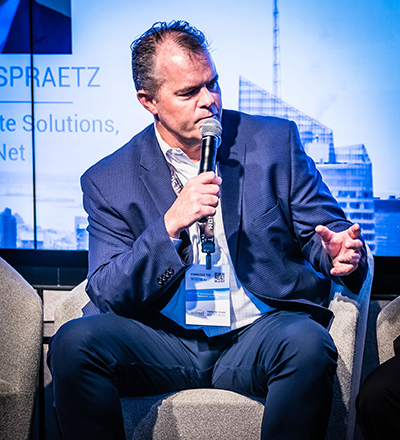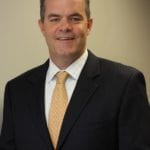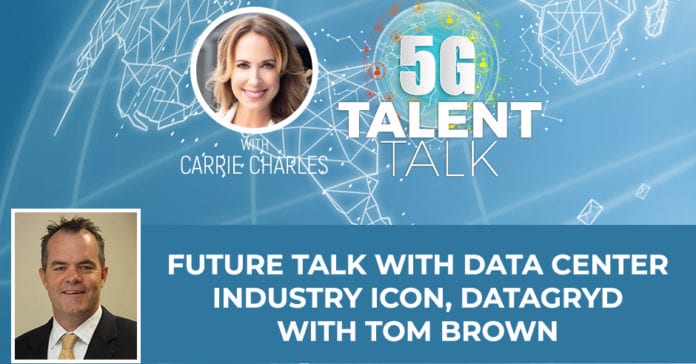With the world thrust into going virtual by the current COVID-19 pandemic, it is no doubt that the data and technology space is seeing an uptick. In fact, they may probably be one of the industries seeing unbelievable growth now. So what does the future look for the data center industry from here on out? Carrie Charles sits down with none other than Tom Brown, the president and CEO of DataGryd—the single largest data center in New York City. Here, Tom shares with us how the COVID-19 pandemic is changing the business and how it is affecting them in both positive and negative ways. He also tells us more about Edge POPs, the hiring process, DataGryd’s culture, and what it’s like working with them. Listen in on this incredible conversation about finding success in uncertain times.
—
Watch the podcast here
Listen to the podcast here
Future Talk with Data Center Industry Icon, DataGryd
I’m super excited to have with me the President and CEO of DataGryd, Tom Brown, Tom, welcome.
I appreciate you taking a few minutes of your day to have me on. If I could, let me share with the audience who DataGryd is. DataGryd is the single largest data center in New York city. I’m sure we’ll talk a little bit about what’s happening in New York city because it’s an epicenter in a lot of different ways. We have the single largest data center encompassing 120,000 square feet in the iconic 60 Hudson Street. Everybody recognizes that address 60 Hudson Street. We’ve been at this since 2011. I joined in 2018 as president CEO to focus on our next evolution of growth. There are two things that I think is important. At 60 Hudson street, there is no meeting room per se that is sanctioned by the building.
You have a number of meeting areas and we’ve been able to mitigate the cross-connect burden that exists in our marketplace nowadays. There’s also another that’s very compelling is our ability to provide dense power applications with the emergence of the Edge POPs with heavy dense power requirements. We have a 15-megawatt power infrastructure fed diversely from the utility in New York city. It’s rather compelling for the folks whether it’s gaming, cloud, traditional service providers, large enterprises, government agencies. It’s broad. We’re now speaking to the wireless, where wireless meets wire lines. I know that you’re involved in Meet Us and that that’s the whole message behind that as well. Excited about what’s taken place. Our whole world turned upside down eight months ago and good thing we’re in this space because we have seen tremendous opportunities come into our pipeline that we probably wouldn’t otherwise seen as a result of this.
Let’s talk about that, Tom. How has business been in 2020 with COVID? Has it affected you in a positive way? Negative way? What about hiring?
We completed. We have two floors. One of which is the fifth-floor, Carrie. That is 60,000 square feet that we did a wholesale deal with then Telex, now DRT. When I joined, we pivoted, and I thought that was critical to do so because the requirements of our customers did not dictate large parcels of space. We are now focused on a minimum requirement of 50 KW. We’re not in the transactional business of the half a rack or rack, but customized solutions for an edge deployment. All the way up, including multiple megawatts. I say that because within our funnel and within this timeframe, we have seen opportunities of that magnitude. The business, we’re seeing opportunities that would otherwise be 2021, maybe even can push out a better later than that moved up. We’re excited about what prospects we have in the funnel and the diversity of the prospects whether it’s a gaming, a cloud, a content, video collaboration, CDNs. These guys are all coming to us to see the value of what we bring to the marketplace.
What’s driving those diverse opportunities. Is it 5G? Is it the network virtualization? What’s driving it?
I think when you think about what’s happened overnight and we all talk about it, “We can’t wait to go back to a conference and meet in person.” I’d love to sit in front of you Carrie and have this conversation because we’re accustomed to doing that, but literally overnight, we had to change what we’re doing. In my opinion, based on what we’ve seen, if you take a look at all the hyperscalers, I’ll use one example, AWS, they, they fortified their network and their growth within that three months from a period in that same time they duplicated what they did in the last twelve months. Microsoft was another one. You’re seeing that. You’re seeing that on the long haul providers, whether it’s CenturyLink, Lumen, all these long haul providers seeing record months to fortify their networks. Interesting to see now that focusing on fortifying the data center space. It’s been exciting for the opportunities that we see.
An amount of construction is underway in the data center space.
That sounds there’s going to be explosive growth over the next year or two years, even five years in the data center industry especially as 5G rolls out.
I sat on another panel and I was with representatives from Cushman & Wakefield and JLL. If you take a look around the space. On a construction, but first and foremost, from a macro level, you seem more than a junior. In 2018, you said, “I think we’ve hit our saturation point. We’re moving outside of Loudon County.” In this time period where we believe that there’s going to be from ‘18 to now ‘20, through ‘22, they’re going to see doubling net space in Northern Virginia alone. It’s startling. If you look at construction, what’s on the construction, out in Silicon Valley, 189 megawatts, Chicago, 137 megawatts. It’s startling the amount of construction is underway in the data center space.
From the Metro, if you look at Phoenix, if you look at Dallas, if you look at New York is still continuing to expand. When we thought that there was saturation, there isn’t. Think about where we were months ago, we were talking about all men about 5G. In my opinion, 5G almost took a back seat because we had to make sure that we were doing what we need to do to have this video conference from her on this morning to make sure. Look at Zoom, went from 30 million simultaneous calls once to $300 million overnight. It was the Zoom room. They doubled their space within 60 Hudson Street. It’s startling, but it’s not temporary. It’s here to stay. I think 5G is going to have another larger impact on that. We’re excited about what the future holds.
Tell me a little bit more about Edge POPs. What does that mean? What’s the purpose?
An Edge POP, for people to have, there are different definitions. Almost to the point where it’s almost a commercial in a sense that it’s, “We’re an Edge POP. You’re an Edge POP. What does an Edge POP mean?” Edge means where the application meets the network. If you think about and whether it’s tier 2, tier 3 markets. If you think about New York City and you think about an aggregation point, you think about 60 Hudson Street. Where we have over 300 service providers. When you have four million eyeballs that sit right outside in the Island of Manhattan, I will tell you that folks have vacated the city. Maybe it’s a 3.5 million eyeballs that sit outside the city of New York, the aggregation point of 60 Hudson Street is key.
We design solutions for our customers that are specifically to meet their needs whether it’s a density from a power perspective. Let me talk a bit about power over the last few years. Even during this pandemic, we’ve seen requirements that are typically 3 to 5 KW per footprint are now 7 to 10, and the way in which we designed it. I tip my cap to my colleague, Art Valhuerdi, who designed this and had the foresight to see this is. We have the ability to provide dense power applications in a condensed small space. The compute power has gotten greater, but the size of the space is not necessarily need to be that large. These Edge POPs are typically between 50 KW and 200 KW. We don’t believe that they’re going to go beyond that size unless it’s more of a wholesale model.
People are exiting New York City. Let’s talk a little bit about what’s happening in New York City. I know that people are moving here to Tampa. Sight unseen, they don’t even need to see the house. What’s that going to mean to your industry in New York?

The advent of internet of things, the advent of artificial intelligence, the advent of 5G, we are in the infancy stage, Carrie, of what the infrastructure is going to look like. I tip my cap to what Ray LaChance and ZenFi Networks are doing, the model for that smart city. They have a boatload of work to do to ensure and to see through their vision. We’ve talked on panels before and people ask, “Where are we at in this whole 5G?” He was like, “If it’s comparable to a game, we’re still warming up and not even in the early innings. There’s still much work that needs to be done. We need aggregation points.” I believe New York City is going to come back. We are resilient. I was in the thick of things here when it was 9/11, when it was super storm Sandy, I was out of my home for 60 days. I believe New York city is the epicenter. It’s unfortunate that this great city has brought themselves to the knees during this unsettling time, but I believe it’s going to be bound. The technology is certainly not going to waiver at all. Far is a great place and, one day I’ll have an address down there. You got a head start, Carrie.
You got it. I love New York City. Good to hear that, that it’s coming back, and all is well in New York and feels good.
Facebook took 1 million square feet right in the heart of Midtown. Google continues to expand. That’s another good point, Carrie. When you think about New York City, 1118 Avenue was a hub that complimented 60 Hudson Street. That has been contracted as a result of the Google Campus. 8510, there’s another building that is home to Microsoft. That is going to be another expansion part of the Google Campus. You’re seeing where they’re drawing talent from the city of New York. It’s good to see that when this all passes that they’re going to continue to expand. Often the talent pool here in New York City. That’s good to see as well.
I segue to talent. I want to talk about talent a bit. Has COVID altered your hiring plans in 2020? Do you see that’s going to affect your hiring plans in 2021? How has it affected you on the workforce side?
DataGryd is owned by a private equity firm and we leveraged heavily on contractors. I know that’s where your expertise is. As we continue to expand, we were bringing in the necessary people, whether it’s on the construction side, the power side, the design side. We leveraged heavily on those constructs. In 2021, as we continue to expand and build out, we have a 1-megawatt data hall and easily we can expand that, but we’ll bring in that talent. We’ll leverage services like you to bring in those subject matter experts. I’m bullish on hiring in the coming year. We’re excited about that.
That’s good news. In fact, a trend that I heard is developing. There was a trend in 2020 that many companies released contractors. They did not hire contract labor. Contract placements went down quite a bit with staffing firms. I hear that the trend is now it’s coming back, that more people are starting to hire contractors and coming into Q4 especially into Q1 and beyond that that’s going to be the way to go. Tell me about DataGryd. Let’s move to your culture. What is it like to work at DataGryd and to be a contractor for DataGryd? Tell me a little about who you are.
When we bring on a contractor, we bring them on as if they are a part of our team. We don’t segregate them and saying, “You’re a contractor. You understand what we need to do to meet and exceed the expectations of our customers.” That’s important when we qualify a particular candidate saying, “You need to meet, exceed the expectations.” One of the differentiators between DataGryd and another option that people might have even our own building is that you are able to make a difference, exceed the expectations of your customers and be in a position to have a seat at the table. What I mean by that is collaborating and making sure that the design in which a client who’s looking to have is that, “Maybe there’s another way of doing it better.” The people we hire are not just these folks who have been able to design before and are subject matter experts. They are a part of our team, email, at DataGryd, business card. They’re part of our team. That’s important to integrate them in as quickly as possible and be able to be empowered to not only suggest, but also make those decisions that ultimately affect the customer experience.
An amount of construction is underway in the data center space.
That is phenomenal because it’s a challenge for many companies when they have permanent employees, full-time employees, and they have contractors how to integrate the contractors into the team, make them feel they’re part of the team and for retention as well. They don’t get pulled away to another contract. There’s this idea that because someone’s a contractor, they’re not as dedicated or committed to the role. How do you feel about that?
That’s why that’s established upfront and we’re setting the expectations. That’s the responsibility of the members of my senior team to convey what the expectations are. You aren’t a “contractor.” You are part of the team. That’s important. I’ll give you an example. We have a contractor that heads up our construction and he’s been with us for five years. Would you call that person an employee? I do, but contractually and the agreement we have with this individual, he’s a contractor, but when we’re in front of a customer, we don’t segregate and say, “Here’s one of our contractors you work with.” No, “This is my colleague. Collectively, we’re going to create a solution for you that’s going to ultimately help you out.” That’s a great success story. There are other contractors, which you and I have spoken about is that this is a defined time. People thrive in that environment where it’s a project that is going to be with a start date, a finish date and there’s goals and incentives within that. People thrive in that environment as well. They move on or they’re able to work simultaneously with other projects that they have and that’s the way they built their business. There’s a lot of complimentary aspects that need to be set up front. It’s worked out well for us.
Tell me what is next for DataGryd in the next few years? What’s your vision?
We have two floors. We have the ability to expand within the building., I believe that we’re continuing to look to expand and address what’s at hand. One of the things that we created and the founding member of is the Independent Data Center Alliance. For us, with our current investment group and ownership is that they want to see this asset at 60 Hudson Street too before we take a look at expanding in a type environment whether it’s Chicago, Los Angeles, Miami where we can replicate the model. I’ve been leveraging my participation in the Independent Data Center Alliance that are data centers, geographically diverse, to provide a global solution for our customers. One throat to choke type of scenario where we can collectively come together. We have Bluebird out in St. Louis, Colon Northwest up in Seattle, MII in New York, Maincubes in Amsterdam and we have a whole other host of folks that are currently evaluating joining the Data Center Alliance. I’m excited about the few years ahead coming up.
It’s wonderful to hear about success in such uncertain times especially when we don’t know what we’re facing, but I do believe that this industry is on its way up and there’s nothing but good things ahead. Tom, you have a podcast. Tell us about your podcast. What’s the name of it? Where can we find it? Where can we listen to it? I know it’s good. You’re a great host.
Thank you, Carrie. I appreciate that. Thank you for allowing me to bring up. We are The Interconnect Hub. We now have over 26 episodes and it’s fun. The idea behind The Interconnect Hub is to bring on industry leaders like yourself to get their perspective, to understand trends, to understand their challenges. We also have prospective customers that come on and talk about some of their challenges and to give you a breath of fresh air of what’s happening. Take a few minutes out of your day whether you’re traveling in the car or you’re working out on a treadmill, whatever it may be to get the insight. We want to be a little bit forward-thinking as opposed to the traditional marketing that we typically leave behind at trade shows but to have some current events and understand the challenges and trends that are in our marketplace. You can find it whether it’s Apple Podcasts, whether it’s a Google Podcast, any podcast where you have, and you listen to podcasts. It’s been much fun to have some great guests on. Thank you for allowing me to share with you The Interconnect Hub.
Everyone go and watch and listen to the podcast. It’s in audio?

It is audio at this time, but I’m going to catch up Carrie because it’s fun.
Especially in this day and age when we don’t get to see people. I enjoy it or see people in person. Where can we find out more about DataGryd?
Thank you, Carrie. It’s www.DataGryd.com, or you can call me and reach out to me directly. I always give out my email TBrown@datagryd.com. Should you have any questions regarding the entire market, let alone New York City, I’ll be more than happy to explore ways in which we can potentially work with anybody.
Wonderful. Tom, thank you for being on the show. I hope to have you back in a few months and let’s see where New York City is, what’s happened after the election, after things settle, definitely would love to have you back. Thanks for being on the show.
Carrie, it’s my pleasure. Thank you for your time. Have a great day.
Take care.
Important Links:
- DataGryd
Independent Data Center Alliance
The Interconnect Hub
Apple Podcasts – The Interconnect Hub
Google Podcast – The Interconnect Hub
TBrown@datagryd.com
About Tom Brown
 Tom Brown is DataGryd’s President and CEO, responsible for planning and implementing the company’s strategy, and managing the overall revenue growth of the company. Mr. Brown joined DataGryd in 2018 and brings more than 25 years of leadership experience in start-up, turnaround and high-growth operations. He has a proven track record of success in strategic and tactical market development, creation of brand awareness and customer relationship management. Prior to joining DataGryd, Mr. Brown led the content, cable, and data center verticals within Windstream’s Wholesale Business Unit. From 1999 to 2009, he was Senior Vice President of Sales and Marketing at FiberNet Telecom Group, Inc., where he was an integral part in the sale of the company to the Zayo Group. Mr. Brown earned a Bachelor of Science degree from the University of Massachusetts at Amherst
Tom Brown is DataGryd’s President and CEO, responsible for planning and implementing the company’s strategy, and managing the overall revenue growth of the company. Mr. Brown joined DataGryd in 2018 and brings more than 25 years of leadership experience in start-up, turnaround and high-growth operations. He has a proven track record of success in strategic and tactical market development, creation of brand awareness and customer relationship management. Prior to joining DataGryd, Mr. Brown led the content, cable, and data center verticals within Windstream’s Wholesale Business Unit. From 1999 to 2009, he was Senior Vice President of Sales and Marketing at FiberNet Telecom Group, Inc., where he was an integral part in the sale of the company to the Zayo Group. Mr. Brown earned a Bachelor of Science degree from the University of Massachusetts at Amherst

